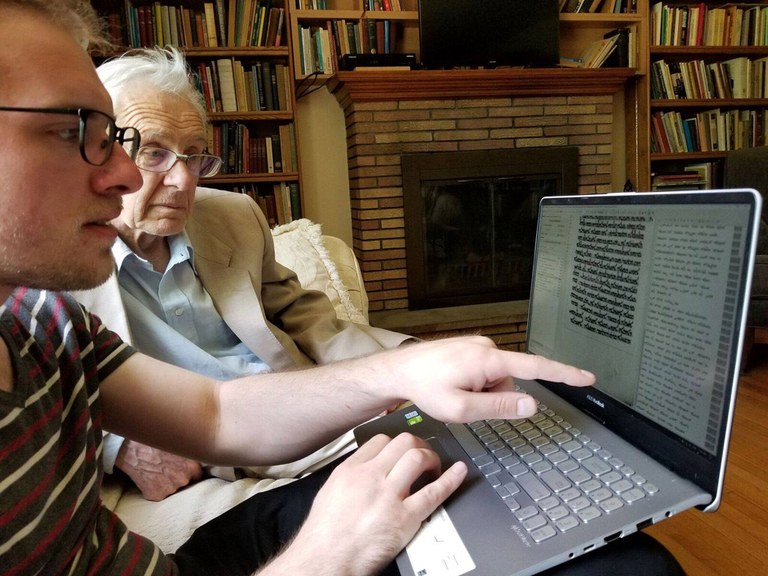ISAW Student Kyle Brunner Receives Digital Humanities Fellowship
This article by Marc LeBlanc first appeared in ISAW Newsletter 25 (Fall 2019).
 Kyle Brunner shows Dr. Sebastian Brock his automated transcriptions of Syriac manuscripts
This past summer, ISAW doctoral student Kyle Brunner was awarded the Dr. Talal and Ms. Wisal Findakly Fellowship in the Digital Humanities at Beth Mardutho: the Syriac Institute. Under the direction of ISAW faculty member Robert Hoyland, Professor of Late Antique and Early Islamic Middle Eastern History, Kyle, who has just started his fourth year at ISAW, is investigating the social history of the early Islamic Middle East along with Arabic and Syriac historiography.
Kyle Brunner shows Dr. Sebastian Brock his automated transcriptions of Syriac manuscripts
This past summer, ISAW doctoral student Kyle Brunner was awarded the Dr. Talal and Ms. Wisal Findakly Fellowship in the Digital Humanities at Beth Mardutho: the Syriac Institute. Under the direction of ISAW faculty member Robert Hoyland, Professor of Late Antique and Early Islamic Middle Eastern History, Kyle, who has just started his fourth year at ISAW, is investigating the social history of the early Islamic Middle East along with Arabic and Syriac historiography.
While at Beth Mardutho, he worked on two main projects with the guidance of Dr. George Kiraz: (1) to test the capabilities of the software “Transkribus” for transcribing Syriac manuscripts, and (2) to catalogue the rare Arabic books in the Beth Mardutho library. Over the course of just three months, Kyle and his team members have developed three unique Handwritten-Text-Recognition (HTR) models for the distinct script styles of Syriac Manuscipts—Estrangelo, Serto, and East-Syrian. Their models are now, under the name “Beth Mardutho Qoruyo HTR,” available freely through the Beth Mardutho website at the following URL: http://bethmardutho.org/qoruyo/. Their models, on average, hit levels of accuracy in the 96–98% range. Their efforts have reduced the time to process unpublished manuscripts to just a few days. They will be publishing new memrē by Isaac of Antioch (fl. 5th c. CE) from various Vatican manuscripts thanks to the support from Dr. Sebastian Brock (Oxford University, emeritus). These new texts will be published online through the Digital Syriac Corpus, headed by Dr. James Walters (Rochester College). Kyle and his team’s efforts at Beth Mardutho represent an important contribution to the fields of Syriac Studies and Digital Humanities.